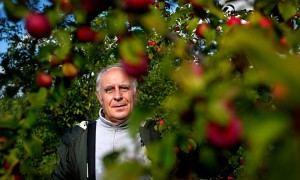Our friends at the Global Crop Diversity Trust have just provided an update on what is happening at the Pavlovsk experiment Station. But don’t go to the Trust’s website, go straight to the Trust’s super-hip Facebook page, which is where you’ll end up anyway. 1
Swedes get a load of Pavlovsk
Dagens Nyheter, A Swedish newspaper, ran a big spread on the Pavlovsk Experiment Station on 5 September. We asked our own favourite Swede to do us a precis. Thanks Britta.
The article is quite basic — after all the audience is the general Swedish public. It is nevertheless well written and presents several arguments for why Pavlovsk should be saved for the future, as well as an overview of the station’s history and past, and why it is now under threat of destruction.
Dagens Nyheter (DN, “Today’s News”) obviously finds the topic interesting as it has sent two people to the Vavilov Institute and Pavlovsk to do their own research and also to join The Committee from Moscow, which visited Pavlovsk on direct Presidential request to investigate if it would be possible to move the the material elsewhere.
Karin Bojs, the author, who is a science journalist, says that there are two big reasons why biologists, agronomists and other individuals are objecting to the plans to turn the area into luxury housing complexes, and now speak out to save Pavlovsk. One reason is the biodiversity that the station houses, the other is the science history that surrounds Russion genebank, including Pavlovsk.

The reporters met with Sergej Alexanian at Vavilov headquarters and with Leonid Burmistrov, who is the head of research at Pavlovsk. Burmistrov says that some of the current project aims are to find genes to solve the biggest problems: resistance to fungal diseases and cold tolerance. Moreover, of course the berries and the fruit need to taste good.
The background and history of Nikolay Vavilov and the Institute that bears his name are described; Vavilov’s travels around the world, his work on genetics and centres of origin, including the story of how scientists starved to death during the siege of Leningrad while sitting in front of bags filled with oats, peas and beans, saving this material and treasuring it beyond their own lives.
Karin Bojs says that everyone seems to agree that the Pavlovsk station houses extremely valuable genetic diversity. The question is whether the material can safely be moved, or not. Staff of the Vavilov institute claim it would be impossible, and they are supported in their claims by international organisations like Bioversity International and the Global Crop Diversity Trust. Sergej Alexanian believes that now that the members of Medvedev’s committee have seen with their own eyes, they too would agree on the difficulties and understand that moving all those trees is not an option.
The bottom line is that there is hope that the Vavilov institute, which has survived the Stalin terror and the siege of Leningrad, has a fair chance of making it through also this chapter of Russian history.
Background:
- Dec 2009 – Russian authorities decide to transfer 90 hectares of farmland managed by the Vavilov Institute to a trust for housing development.
- [April 2010 Agricultural Biodiversity Weblog draws attention to the problem. Ed.]
- June 2010 – Cary Fowler visits Pavlovsk and raises media interest. New Scientist article. Thousands of internet signatures for the cause.
- 11 August 2010 – A court in Moscow rules that the matter has been handled correctly and that the building trust has full rights to the land. Pavlovsk staff can no longer weed the grounds, replant or chase away fruit thieves.
- 12 August 2010 – The save Pavlovsk campaign intensifies and is also run on Twitter. More than 30,000 individuals have signed protest letters.
- 13 August – President Medvedev informs that he will look into the matter.
- 31 August – A committe with representatives from different stakeholders and institutes travels to Pavlovsk to investigate if it would be possible to move the plants.
- 9 September – Russian Accounts Chamber says it will visit Pavlovsk on 15 September. Ed.
A Pavlovsk lifeline
You’ll remember that the Russian Housing Development Foundation wants to build a luxury housing project on the site of the Vavilov Institute of Plant Industry’s (VIR) unique fruit and berry germplasm collection at the Pavlovsk Experimental Station near St Petersburg. And that the conservation community has been trying to assist VIR’s staff via a petition in their attempts to stop this wanton destruction. Well…
…mounting pressure from scientists has now resulted in at least partial success. The RHDF has announced to ask an independent international expert commission to evaluate the situation at Pavlovsk before proceeding with its plans. Moreover, the Russian Accounts Chamber, a body controlling federal budgets, has announced to inspect the station on 15 September.
Great news indeed. But we’re not out of the woods yet. 2 It’s undoubtedly a victory, but we need to keep that pressure up.
Nibbles: Bees, Genebanks, Livestock, Deforestation
- 17 years of data confirm fears of bee decline.
- Slideshow on Egyptian Deserts Genebank; prepare to be astounded.
- Slideshow on US National Plant Germplasm System; prepare to be even more astounded.
- Livestock and climate change, a background paper from ILRI.
- “Most new farmland comes from cutting tropical forest.” The good news: it’s corporate, so can be pressured to stop.
The not so boring B-301 cowpea
Have a look at the comments to this post of ours from a few days back and then tell me that germplasm documentation doesn’t need a social networking makeover.